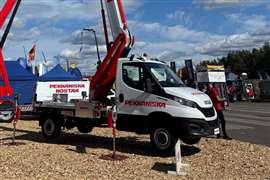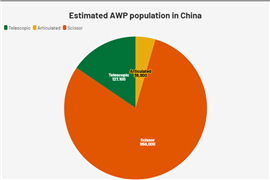Good visibility
20 March 2008

IRN: United is already the world's biggest equipment rental company, where do you see further growth coming from? MJK:
From an operational standpoint, we have numerous avenues for growth. The North American marketplace is still under-penetrated when it comes to equipment rental; industry sources estimate less than 40% penetration in the construction sector. Some of the most exciting opportunities exist within the government sector and industry. We announced in May that United Rentals has earned GSA status, which allows us to do business with branches of the US government.
Private manufacturing and industry have been even more prone to owning their own equipment. This is partly a habit, and partly due to labor agreements that constrain certain types of change. We have seen many situations where a change of ownership triggers a paradigm shift. The sector presents some challenges, but there is still ample opportunity for us to pursue this business.
Everyone in our company understands that our mission is growth. Truck drivers have as much information about a territory as sales reps or branch managers. Our drivers are out there every day on jobsites where the trends begin, where competitors are, where opportunities are. They can help grow the company.
IRN: What is the overall operating environment like in North America? MJK:
Every indication is that United Rentals and the customers we serve will be operating in a positive construction environment for some time. We constantly take the temperature of market conditions in our regions, and we're very comfortable with what we see at this point. We have reasonable visibility through 2007 and into 2008, with a number of large project commitments in place.
IRN: So construction spending is still strong? MJK:
Our primary market in the US and Canada is private non-residential construction. This market spent 15,6% more in the first quarter compared with first quarter 2006. Our expectation is that spending will continue to increase this year, and in fact through 2008, although we do agree with industry analysts who feel that the growth rate will likely moderate.
Within private non-residential construction, we have seen the strongest demand for equipment come from the retail, manufacturing and healthcare sectors. These are the same sectors that drove market demand last year-not only with new construction, but also equipment used for facility expansion, refurbishing and maintenance. Residential construction, on the other hand, has been weak to moderate at best in the States. Homebuilding is a secondary market for us, but we do see the impact in areas such as southern California where we have a high concentration of branches that serve those contractors.
IRN: You recently announced that you plan to increase your capital expenditures in rental fleet this year, beyond the original plan. What prompted that decision? MJK:
We purchased US$265 million (€200 million) of fleet in the first quarter, about 30% of our rental capex plan. Most of this fleet was absorbed into our branches by mid-March when we began to see time utilisation trend upwards. During April time utilisation was up more than two percentage points year-over-year.
Given our confidence in the current operating environment and our visibility into 2008, we decided in May to increase growth capital by another $50 million (€38 million) this year. When we improve time utilisation on an expanded fleet, as we are doing now, it indicates that there is a strong, underlying demand for our equipment. Our focus, as always, is on our customers and our ability to meet their needs.
IRN: Is utilisation a key focus for your company? MJK:
Our branch teams understand the importance of achieving an optimum balance of rates and utilisation on existing fleet. Fleet management is a complex process; it involves rates management, geographic analysis, sales management and customer service. Our current business strategy is extremely focused on improving our margins and accelerating earnings growth. Effective fleet management is one of the most important things we can do to support these goals.
IRN: Right now, your fleet mix is about 40% aerials. Do you intend to keep that percent intact as you make future fleet investments? MJK:
We try not to make assumptions about future fleet mix until the capital investment period-that's when demand is analysed. The mix really is determined by the needs of our customers. What I can tell you is that we are very comfortable with access equipment accounting for about 40% of our fleet at this time. Aerial was one of the top performing regions in our company in 2006. This looks like it will be another strong year. It's a business where scale matters; we are often asked to provide 50 or more lifts to large projects that require months or even years of construction.
IRN: What future opportunities do you see for United Rentals? Will you look at expanding into rental markets overseas?
United says private, non-residential construction remains strong in the US. MJK:
We have always been open to attractive growth opportunities beyond our current markets, although we are not actively pursuing them at this time. As I mentioned earlier, there is plenty of growth to be found in our own backyard. United Rentals has had an aggressive and highly successful cold start program in place since 2005. We established more than 70 new branches in the last two years and plan another 30 to 35 openings by December.
IRN: Share one long-term objective that has your attention now. MJK:
I strongly believe that the equipment rental industry in North America needs to do a better job of communicating the attractiveness of this business. We have failed to express that we are a viable, attractive industry for young people who want to build a fulfilling career. We need to work at educating those outside our own realm. At United Rentals we're asking manufacturers to step up to the plate with us to provide training and outreach to schools.
The future of the rental industry is its people. That holds true whether you operate in North America or Europe or Great Britain or Asia. The easiest thing for a large rental company to do is buy equipment and real estate, but between the equipment and the customer are many people who make this business happen.
IRN: 2007 is United Rentals’ tenth anniversary year. How will the company approach its next decade? MJK:
One of the great strengths of our organization is that we stay true to our legacy of innovation, creativity and change. United Rentals was founded on these concepts. Today, when I look at the industry, change is evident everywhere-not only with the physical infrastructure of the business, but with customers as well. We have a fluid organization that adapts quickly to change and opportunity.
There is a lingering perception that the construction industry is somewhat slow to adopt new methods. And yet when you look at construction today compared with 10 years ago, it is far different. Today's contractors use planning software and CAD systems and GPS systems. They have many incentives to complete jobs more productively. In the 1980s it was typical for construction of an auto plant in the US to take three or four years from start to finish. Today, that span has been cut to 18 or 20 months.
STAY CONNECTED



Receive the information you need when you need it through our world-leading magazines, newsletters and daily briefings.
CONNECT WITH THE TEAM











